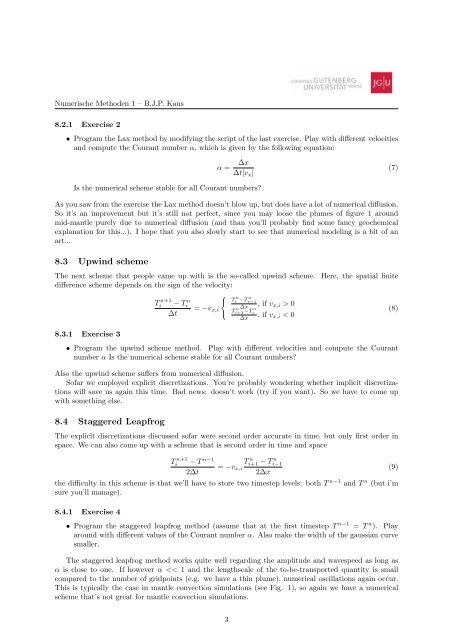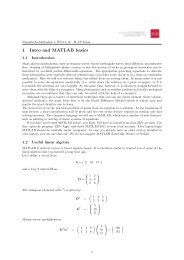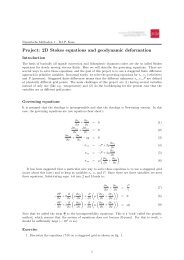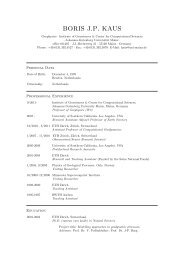8 Advection equations and the art of numerical modeling
8 Advection equations and the art of numerical modeling
8 Advection equations and the art of numerical modeling
- No tags were found...
You also want an ePaper? Increase the reach of your titles
YUMPU automatically turns print PDFs into web optimized ePapers that Google loves.
Numerische Methoden 1 – B.J.P. Kaus8.2.1 Exercise 2• Program <strong>the</strong> Lax method by modifying <strong>the</strong> script <strong>of</strong> <strong>the</strong> last exercise. Play with different velocities<strong>and</strong> compute <strong>the</strong> Courant number α, which is given by <strong>the</strong> following equation:α =∆x∆t|v x |(7)Is <strong>the</strong> <strong>numerical</strong> scheme stable for all Courant numbers?As you saw from <strong>the</strong> exercise <strong>the</strong> Lax method doesn’t blow up, but does have a lot <strong>of</strong> <strong>numerical</strong> diffusion.So it’s an improvement but it’s still not perfect, since you may loose <strong>the</strong> plumes <strong>of</strong> figure 1 aroundmid-mantle purely due to <strong>numerical</strong> diffusion (<strong>and</strong> than you’ll probably find some fancy geochemicalexplanation for this...). I hope that you also slowly st<strong>art</strong> to see that <strong>numerical</strong> <strong>modeling</strong> is a bit <strong>of</strong> an<strong>art</strong>...8.3 Upwind schemeThe next scheme that people came up with is <strong>the</strong> so-called upwind scheme.difference scheme depends on <strong>the</strong> sign <strong>of</strong> <strong>the</strong> velocity:Here, <strong>the</strong> spatial finiteT n+1i− Tin∆t= −v x,i{ Tni −T n i−1∆x, if v x,i > 0T n i+1 −T n i∆x, if v x,i < 0(8)8.3.1 Exercise 3• Program <strong>the</strong> upwind scheme method. Play with different velocities <strong>and</strong> compute <strong>the</strong> Courantnumber α Is <strong>the</strong> <strong>numerical</strong> scheme stable for all Courant numbers?Also <strong>the</strong> upwind scheme suffers from <strong>numerical</strong> diffusion.S<strong>of</strong>ar we employed explicit discretizations. You’re probably wondering whe<strong>the</strong>r implicit discretizationswill save us again this time. Bad news: doesn’t work (try if you want). So we have to come upwith something else.8.4 Staggered LeapfrogThe explicit discretizations discussed s<strong>of</strong>ar were second order accurate in time, but only first order inspace. We can also come up with a scheme that is second order in time <strong>and</strong> spaceT n+1i− T n−12∆t= −v x,iT n i+1 − T n i−12∆x<strong>the</strong> difficulty in this scheme is that we’ll have to store two timestep levels: both T n−1 <strong>and</strong> T n (but i’msure you’ll manage).(9)8.4.1 Exercise 4• Program <strong>the</strong> staggered leapfrog method (assume that at <strong>the</strong> first timestep T n−1 = T n ). Playaround with different values <strong>of</strong> <strong>the</strong> Courant number α. Also make <strong>the</strong> width <strong>of</strong> <strong>the</strong> gaussian curvesmaller.The staggered leapfrog method works quite well regarding <strong>the</strong> amplitude <strong>and</strong> wavespeed as long asα is close to one. If however α






